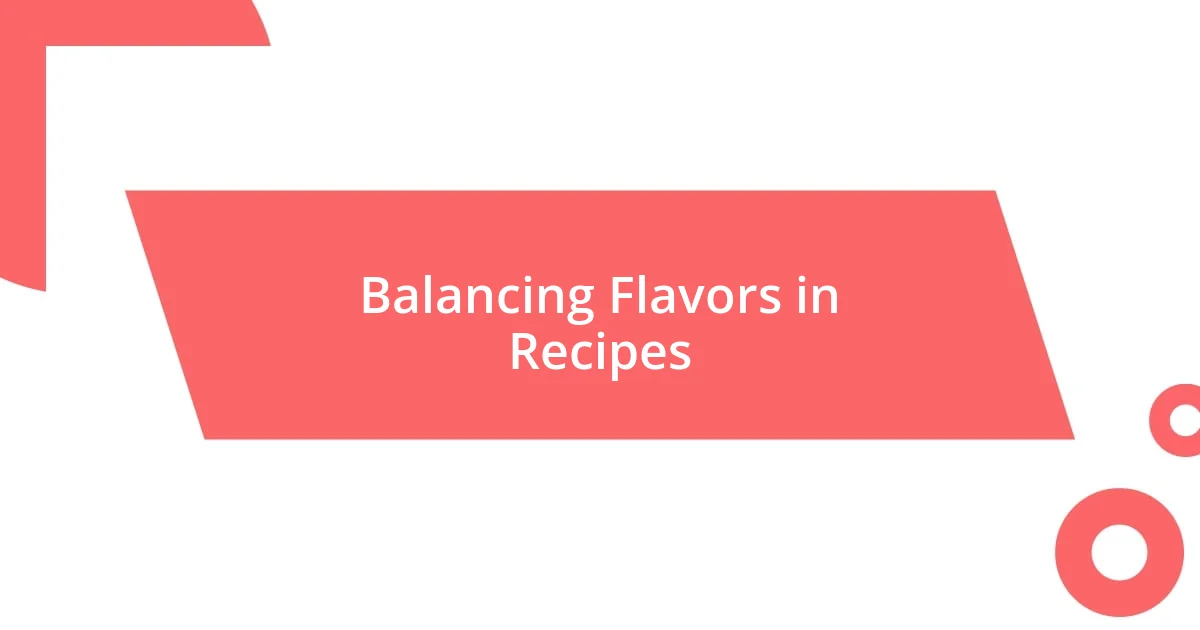Key takeaways:
- Understanding spice flavor profiles enhances dishes; unique combinations like cayenne and cardamom create memorable taste experiences.
- Choosing quality spices involves assessing aroma, preferring glass packaging, and sourcing from local markets for freshness.
- Experimenting with flavor pairings, such as cinnamon with black pepper or vanilla with rosemary, can lead to surprising and delightful culinary results.

Understanding Spice Flavor Profiles
When I first began exploring spice flavor profiles, I was amazed by how each spice has its own unique personality. For instance, the warmth of cinnamon instantly invokes feelings of nostalgia for me, reminiscent of baking with my grandmother during the holidays. Have you experienced that special connection with certain spices?
Understanding the interplay of spices can truly elevate a dish. One of my favorite combinations involves balancing the heat of cayenne pepper with the sweetness of cardamom. It creates this delightful dance on the palate, making every bite a little adventure. Don’t you agree that it’s those surprising flavor marriages that often leave a lasting impression?
As I’ve learned more, I’ve discovered how spices can transform a meal based on their origin and even the cooking method. For example, toasting spices lightly in a pan can unlock deeper, more complex flavors that don’t emerge when they’re added straight into a pot. Have you ever tried this technique? It’s a simple change that turns a good dish into an unforgettable one.

How to Choose Quality Spices
Choosing quality spices can profoundly influence the flavors of your dishes. As I’ve noted from experiences in both stores and spice shops, freshness is paramount. When I select spices, I always take a moment to assess their aroma. If the scent is weak, I steer clear—it’s a sure sign of age and diminished flavor potency. Have you ever opened a jar that just didn’t smell right? It’s a letdown, to say the least.
The packaging can also tell us a lot about the quality of spices. I prefer spices in glass jars over plastic containers; glass helps preserve their potency better and protects against moisture. Many times, I’ve bought spices that were sealed in air-tight packs, only to find they lost their vibrancy. This is especially true for herbs; the color should be vibrant, indicating freshness. What about you? Do you pay close attention to the packaging when you shop for spices?
Another vital factor is sourcing. I’ve discovered that local markets often carry fresher spices than larger grocery chains. They offer a broader variety and, I find, a chance to chat with knowledgeable vendors about growing and harvesting practices. Just a few weeks ago, I stumbled upon a small stall that sold locally sourced smoked paprika; the flavor was unparalleled compared to what I’d previously used. Isn’t it exciting to uncover such gems?
| Quality Indicator | Your Insights |
|---|---|
| Aroma Intensity | Should be strong; weak aroma indicates age. |
| Packaging Type | Glass jars are preferable; they preserve potency. |
| Color Vibrancy | Bright colors denote freshness, especially in herbs. |
| Sourcing Location | Local markets often offer fresher, higher-quality spices. |

Techniques for Blending Spices
Blending spices is more of an art than a science, and I find that experimenting with ratios can lead to some delightful surprises. I often start with a base of complementary spices, then gradually introduce others to see how their flavors interact. Just the other day, I was trying to add depth to a curry and found that a pinch of smoked paprika beautifully enhanced the dish without overpowering the other flavors. It felt like a light bulb moment!
- Start with a base: Choose a primary spice as your foundation, like cumin or coriander.
- Experiment incrementally: Add additional spices gradually, tasting as you go to find the perfect balance.
- Consider texture: Some spices can be ground into a powder, while others, like bay leaves, are best left whole to infuse flavor.
- Toast spices: Lightly toasting whole spices in a dry pan before blending can unlock richer flavors and aromas.
- Create blends in advance: When I find a winning combination, I mix them in bulk and store them in an airtight container for easy use later on.
Understanding how spices work together can change your culinary experiences entirely. Recently, I made my go-to chili recipe and decided to play with a mix of smoky and sweet. The combination of chipotle powder and a hint of brown sugar gave the chili an unexpected richness that had everyone at the table asking for seconds. It’s moments like these that remind me of the magic that happens in the kitchen!

Balancing Flavors in Recipes
Balancing flavors in recipes is essential for creating a harmonious dish. I often think of it as a dance between sweet, salty, sour, and bitter elements. The other day, while making a salad, I opted for a tangy vinaigrette that balanced the sweetness of ripe strawberries perfectly. Can you imagine how off-putting a dish can be when one flavor overwhelms the others? It’s like a solo performance instead of a beautifully choreographed routine.
I’ve learned through trial and error that understanding the role of each flavor can elevate a dish. For example, when preparing a savory stew, I usually add a splash of vinegar or citrus at the end. This brightens everything up, cutting through the richness and making the flavors pop. Just last week, I made a classic beef stew and added a squeeze of lemon juice before serving. The transformation was astonishing—suddenly, the dish was vibrant rather than heavy. It’s in these moments that I realize how small adjustments can lead to big rewards.
Don’t underestimate seasoning; it can shift the balance dramatically. I remember a time I baked a chocolate cake that lacked complexity. I decided to sprinkle in a pinch of sea salt to enhance the sweetness, and the flavor profile exploded in a way I never anticipated. Have you ever had that experience where you finally found the secret ingredient that took your dish to another level? It feels like uncovering a hidden treasure in your kitchen!

Common Spice Combinations to Try
One combination I absolutely love is the trio of garlic, ginger, and turmeric. This mix is a staple in many Asian dishes and for good reason! The fragrant warmth of ginger, the pungency of garlic, and the earthiness of turmeric come together to create a base that’s packed with flavor. I remember the first time I used this combination to marinate chicken; the aroma wafting through my kitchen was irresistible. Have you ever tried a marinade that made you excited for dinner? This one certainly did the trick!
Another fantastic pairing is cumin and coriander. These two spices complement each other beautifully, with cumin providing a warm, nutty depth and coriander adding a fresh, citrusy note. I often turn to this combination when preparing a simple bean dish. Just a sprinkle of each, along with some salt, transformed what could have been a bland side into something vibrant and nourishing. It’s like a chef’s secret weapon that boosts flavor without complicating the process. Who knew such a simple blend could elevate a dish so effortlessly?
Let’s not overlook the classic Italian combination of basil and oregano. The first time I tossed these herbs into a bubbling tomato sauce, I was amazed at how they transformed the flavor profile. The aromatic basil brought a sweetness that beautifully balanced the savory oregano. Just think about how beautiful a plate of pasta can be when it’s dressed with a sauce that sings! It’s those small touches that turn a good dish into a great one, making every meal feel special and inviting.

Tips for Storing Mixed Spices
When it comes to storing mixed spices, I’ve found that air-tight containers are key. Not only do they keep moisture at bay, but they also prevent the spices from losing their potency. I remember a time I stored a homemade spice mix in a regular jar—what a difference it made when I switched to glass, tightly sealed jars. The scents were so much more vibrant, and I felt like I could taste the love I put into that blend every time I reached for it.
Another crucial tip I swear by is keeping spices in a cool, dark place away from heat sources. I used to store my spices right above the stove, thinking the convenience outweighed the potential loss of flavor. But after a few months, the spices lost their zing, and dish after dish fell flat. Moving them to a pantry helped breathe new life into my cooking. Have you experienced the frustration of using spices that no longer deliver their promised flavor?
Lastly, I like to label my spice jars with the date I made the mix. Spices can lose their flair over time, and knowing when to refresh them keeps my cooking exciting. I guess you could say it’s like keeping a diary of flavors—something I often refer back to when trying to replicate a dish. It brings a personal touch to my kitchen that I cherish. Do you ever feel a connection to your cooking that goes beyond just feeding yourself? Keeping track of spices in this way makes the experience more meaningful for me.

Experimenting with Unique Flavor Pairings
Experimenting with unique flavor pairings is one of the most thrilling parts of cooking. Last week, I decided to try a blend of cinnamon and black pepper in a savory stew. The warmth of the cinnamon surprised me, creating a sweetness that paired unexpectedly well with the heat of the black pepper. Have you ever stumbled upon a flavor combination that left you questioning why you hadn’t tried it before? Those moments are what keep me excited in the kitchen!
One of my memorable experiments involved mixing smoked paprika with a hint of cardamom. Initially, I was hesitant; cardamom is quite strong, but when used sparingly, it added a fragrant depth that complemented the smoky richness of the paprika perfectly. I recall serving it to friends, and their reactions of sheer delight made all the risk worthwhile. How often do we shy away from bold choices, fearing we might miss the mark? Taking that leap, in my opinion, is where the magic truly happens.
I also enjoy playing with sweet and savory flavors, like pairing vanilla with rosemary. It might sound odd at first, but the two flavors together create a complex aroma that I can’t get enough of. I tossed them into a batch of roasted carrots, and the result was transformative. Have you ever been surprised by how a simple dish can become extraordinary just by daring to combine unexpected spices? For me, this adventurous spirit in the kitchen has led to some of my most cherished recipes.















